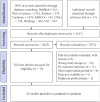Comparative efficacy of different exercise types on body composition in university students: a systematic review and meta-analysis of randomized controlled trials
- PMID: 40330251
- PMCID: PMC12053280
- DOI: 10.3389/fphys.2025.1537937
Comparative efficacy of different exercise types on body composition in university students: a systematic review and meta-analysis of randomized controlled trials
Abstract
Background: To systematically assess the impact of various exercise modalities and dosages on the body composition of college students through a comprehensive review of randomized controlled trials (RCTs).
Methods: We conducted a comprehensive search of relevant randomized controlled trials (RCTs) in eight databases, covering data from the inception of each database to August 2024. Following the literature screening, two investigators independently conducted data extraction and assessed the risk of bias. Network meta-analysis (NMA) was conducted using Stata 17.0 with random-effects modeling, while dose-response analysis was performed utilizing R version 4.3.1.
Results: A total of 43 randomized controlled trials (RCTs), encompassing 3,154 participants, were included in the analysis. Aerobic exercise, combined exercise, high-intensity interval training (HIIT), mind-body exercise, and calisthenics demonstrated significant effects on reducing body mass index (BMI) compared to control groups. Surface under the cumulative ranking (SUCRA) probability rankings indicated that calisthenics had the highest likelihood of being the most effective intervention for BMI reduction, whereas resistance exercise was associated with the lowest likelihood. The dose-response analysis revealed that the threshold exercise dose for overall exercise to lower BMI was 310 METs-min/week, with the predicted maximum significant response dose being 1,300 METs-min/week, beyond which there was minimal change in the intervention effect. Additionally, distinct nonlinear dose-response relationships were observed for aerobic exercise, combined exercise, HIIT, mind-body exercise, and aerobics.
Conclusion: No significant differences in the effectiveness of exercise interventions on body composition were observed across exercise types. However, based on the SUCRA analysis, calisthenics emerged as the preferred intervention, succeeded by a combination of exercises. The optimal exercise dosage for enhancing body composition was identified as 1,300 METs-min/week, with the threshold for a significant effect being relatively low.
Systematic review registration: https://www.crd.york.ac.uk/PROSPERO/view/CRD42024587032.
Keywords: BMI; body composition; dose; exercise; network meta-analysis; obesity; systematic evaluation.
Copyright © 2025 Li, Zang, Hao and Wang.
Conflict of interest statement
The authors declare that the research was conducted in the absence of any commercial or financial relationships that could be construed as a potential conflict of interest.
Figures






Similar articles
-
Optimal exercise dose and type for improving sleep quality: a systematic review and network meta-analysis of RCTs.Front Psychol. 2024 Oct 3;15:1466277. doi: 10.3389/fpsyg.2024.1466277. eCollection 2024. Front Psychol. 2024. PMID: 39421847 Free PMC article.
-
Comparative efficacy of different exercise modalities on metabolic profiles and liver functions in non-alcoholic fatty liver disease: a network meta-analysis.Front Physiol. 2024 Sep 11;15:1428723. doi: 10.3389/fphys.2024.1428723. eCollection 2024. Front Physiol. 2024. PMID: 39376897 Free PMC article.
-
Comparative efficacy of different exercise methods to improve cardiopulmonary function in stroke patients: a network meta-analysis of randomized controlled trials.Front Neurol. 2024 Jan 17;15:1288032. doi: 10.3389/fneur.2024.1288032. eCollection 2024. Front Neurol. 2024. PMID: 38313560 Free PMC article.
-
Comparison of different exercise modalities on fatigue and muscular fitness in patients with multiple sclerosis: a systematic review with network, and dose-response meta-analyses.Front Neurol. 2024 Nov 26;15:1494368. doi: 10.3389/fneur.2024.1494368. eCollection 2024. Front Neurol. 2024. PMID: 39659961 Free PMC article.
-
Optimal exercise dose-response improves health-related quality of life in cancer survivors: a systematic review and Bayesian network meta-analysis of RCTs.Front Oncol. 2024 Dec 16;14:1510578. doi: 10.3389/fonc.2024.1510578. eCollection 2024. Front Oncol. 2024. PMID: 39737404 Free PMC article.
References
-
- Al-Mhanna S. B., Batrakoulis A., Mohamed M., Alkhamees N. H., Sheeha B. B., Ibrahim Z. M., et al. (2024b). Home-based circuit training improves blood lipid profile, liver function, musculoskeletal fitness, and health-related quality of life in overweight/obese older adult patients with knee osteoarthritis and type 2 diabetes: a randomized controlled trial during the COVID-19 pandemic. BMC Sports Sci. Med. Rehabil. 16, 125. 10.1186/s13102-024-00915-4 - DOI - PMC - PubMed
-
- Al-Mhanna S. B., Batrakoulis A., Wan Ghazali W. S., Mohamed M., Aldayel A., Alhussain M. H., et al. (2024a). Effects of combined aerobic and resistance training on glycemic control, blood pressure, inflammation, cardiorespiratory fitness and quality of life in patients with type 2 diabetes and overweight/obesity: a systematic review and meta-analysis. PeerJ 12, e17525. 10.7717/peerj.17525 - DOI - PMC - PubMed
Publication types
LinkOut - more resources
Full Text Sources

